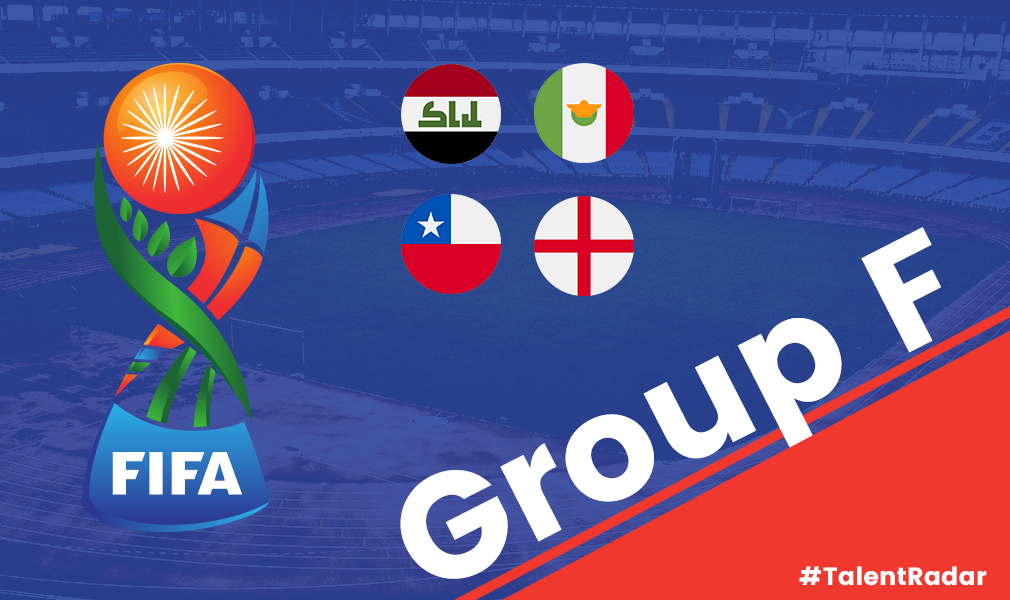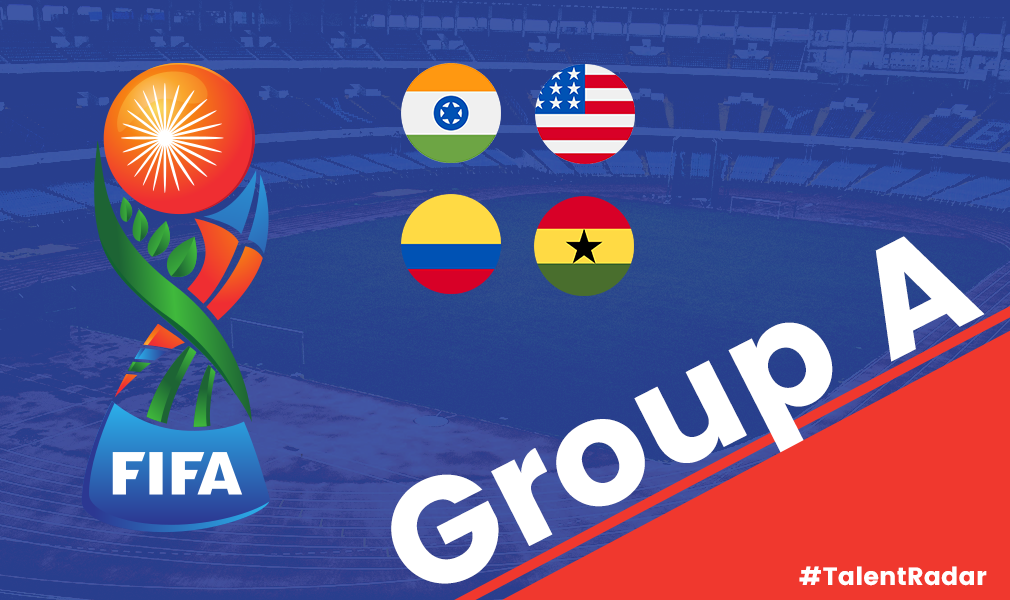Nachiketh Ramesh writes a detailed tactical analysis of Chile’s win over Colombia in the Copa America 2016 semi final.
Chile was good against Colombia. In fact, Chile was better than Colombia in many aspects of the game. But to say that Chile was extraordinary would be an exaggeration of the abilities of the reigning Copa America champions. Charles Aranguiz and Jose Fuenzalida scored in the space of five minutes at the beginning of the game and those two goals were more than enough to hold Colombia off. But what followed the goals was a lackluster performance. Having high expectations on a good team seems to be backfiring, for me at least, as Chile, very much like Mexico, is looking as if they are going to fall down from the top at a crucial point in the tournament. Ramblings aside, here’s a tactical report of the game:
Jose Pekerman, Colombian manager, started with Diego Ospina between the sticks. Frank Fabra and Santiago Arias flanked the central defensive pair of Jeison Murillo and Cristian Zapata. Daniel Torres and Carlos Sanchez played in the central midfield. James Rodriguez, Edwin Cardozo and Juan Cuadrado were the attacking midfielders. Roger Martinez played as the striker.
Chile manager, Juan Antonio Pizzi started with Alexis Sanchez and Eduardo Vargas upfront. Pablo Hernandez, Francisco Silva, Aranguiz and Fuenzalida followed them in the midfield. Jean Beausejour, Gonzalo Jara, Gary Medel and Mauricio Isla formed Chile’s backline. Claudio Bravo was the goalkeeper.
Colombia 0-2 Chile

Chile’s flexible shape
Fuenzalida, who was playing on the right wing, had a major influence on Chile’s shape during the attacking phase. Fuenzalida, playing in the midfield, offered attacking assistance and defensive support to Chile. So, he was more or less a right wingback. Whenever Fuenzalida was joining the forwards in the attacking line, Sanchez was moving a little wide into the channels and Chile was changing to a lop sided 4-3-3.

Chile in a lopsided 4-3-3
When Colombian forwards, Martinez and Rodriguez, were pressing the Chilean central defenders, Jara and Medel, defensive midfielder, Silva, was dropping into the space between central defenders. Silva was helping Chile attain numerical superiority at the back. This ensured a smooth build-up of attack from the back. With Silva’s backward movement, Chile was shifting to a 3-4-3 formation. Fuenzalida was staying in the attacking line.
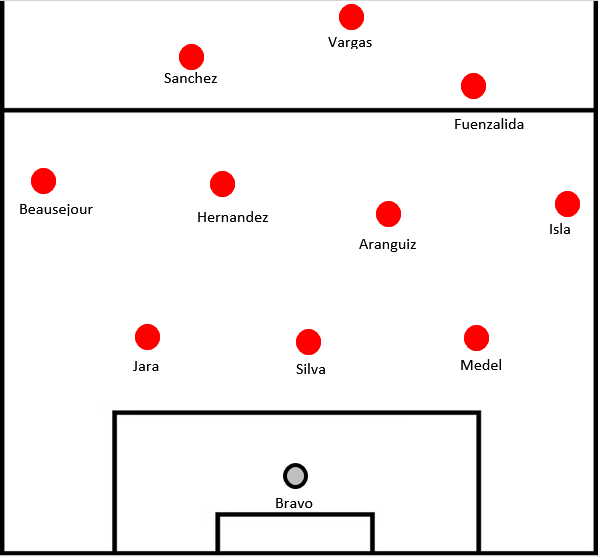
Chile during build ups- a 3-4-3
During the defensive phase of the game, Chile was situationally moving a 5-3-2 or 3-5-2 formation while defending the ball on the wings. 3-5-2 while defending in the midfield and 5-3-2 while defending the ball in a deeper positon.
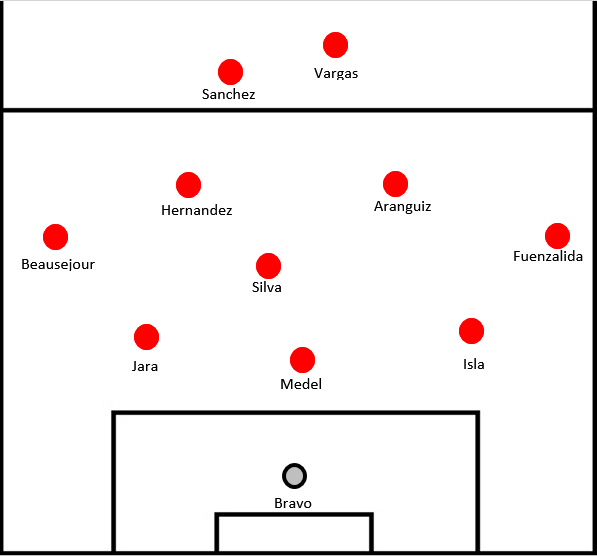
Chile in a 5-3-2
Chile’s attacks
As said earlier, Fuenzalida was more a wingback than a winger. This meant Chile had two wingbacks on one side in Isla and Fuenzalida. But it was a risky tactic deployed by Pizzi. With both Fuenzalida and Isla in the playing eleven, Pizzi had be content without a natural winger to test the opposition wingbacks, Fabra and Arias. However, the ex-Valencia manager decided to target one of the two opposition wingback, Fabra, and tantalize him by putting Isla and Fuenzalida against him.
The main intent or aim of Chile’s attacks in the first twenty minutes was to make some space for Fuenzalida to run at and Isla to follow his lead. With a 2 on 1 advantage over Fabra, one of them was crossing the ball inside for the on rushing Sanchez, Vargas, Aranguiz and Hernandez, who was making runs into the box thanks to his advanced position. The first goal demonstrated Chile’s plans.
Chile’s left central midfielder, Hernandez, was not always positioned close to the centre circle. To halt Colombian right back Arias’ runs and prevent possible overloads created by him and Cuadrado on Beausejour, Hernandez was moving higher up the pitch. With this, Sanchez was shifting wide to engage with Arias. Chile were thus transforming into a 2-4-4 shape while attacking in the early stages of the match.
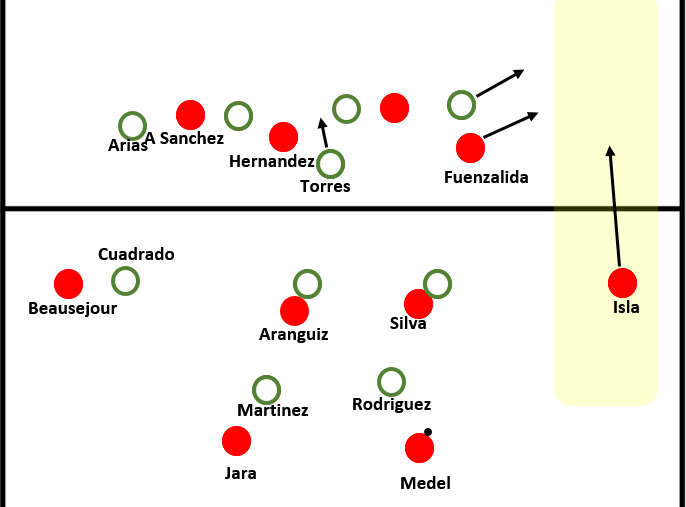
Chile creating space on the right wing by moving into a 2-4-4 formation
As Isla, who was free on the right wing, was moving higher up, Fuenzalida was joining him. This was provoking Fabra to leave his position in order to press them. During such situations Chile was creating overloads in their front line. This was forcing Colombian midfielder Torres to stay deep and at times join the defensive line to equate the numbers.
So Chile had enough players inside the box to head the cross and two players – Aranguiz and Fuenzalida, to pounce on the rebounds and second balls. Chile’s second goal came as a result of Bravo’s long ball to Sanchez. Sanchez’s rebound was scored by Fuenzlida who’s run was uncontested by Colombian defenders.
Looking at the above picture one can see how well Chile is manipulating the Colombian formation to make space on the right flank. Chile didn’t have central access and so penetration through the centre was not possible. This was a disadvantage of having two wide players on one flank. But Chile, before Colombia could find out what was happening, salvaged whatever was possible from this wing advantage.
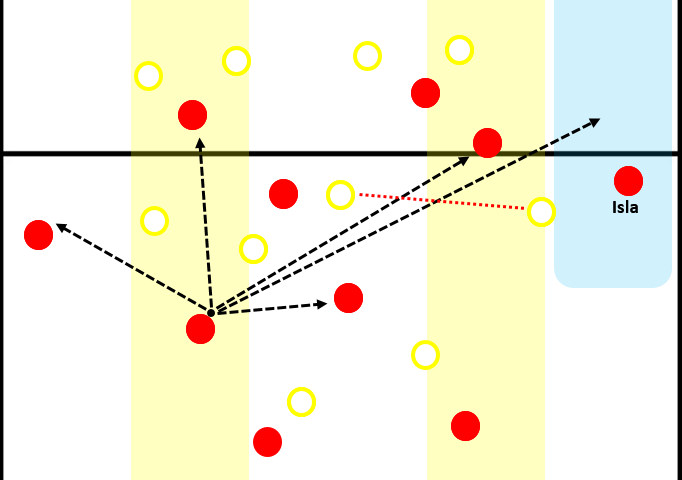
Player in half-space and the passing options. Cardona is not helping Colombia maintain a compact shape.
Chile utilized its half-space positioning well in order to pose a threat to the Colombian defensive structure. Say a Chile player was in the left half-space, then Cuadrado and Arias had to narrow down thus leaving space for Beausejour on the left flank. Also, Colombia’s midfield line had to shift towards the ball and orient itself with respect to the ball. While, Torres and Carlos Sanchez were moving towards the ball, the far side wide midfielder – Cardona was not shifting with the chain. This was leaving space open in the middle for Chile to exploit. Cardona was confused – whether to stay wide and keep an eye on Isla or to stay in the right half-space close to Fuenzalida or tuck inwards and block Chile’s central access. This confusion and odd shape was partly due to the way Chile spread themselves during the attack and partly due to the occupation of both the half-spaces. In simple words, Chile was manipulating Colombian midfield and thus their defensive shape.
Chile fail to counterpress, had spacing issues and lacked horizontal compactness. Colombia’s attacks.

While Chile had the ball in a deep central zone, Colombia blocked central areas. Chile took advantage of its superiority on the right flank. But let us take a look at this graphical image from a different perspective.
As soon as the ball was lost somewhere in Colombia’s half, the Colombian wingbacks were bombarding high up the pitch. Also, Chile midfielders were outnumbered due to the involvement of Rodriguez and Cardona, who was staying narrow while attacking.
Since Chile had nearly four players pinned up against Colombian defenders, when the ball was lost there was not enough support for Silva and Aranguiz to counter press in the central zones and half-spaces. Colombia was finding some space in the middle to play or a free player to conduct the play forward. Hernandez, as said earlier, was in an advanced position. The absence of a third central midfielder was felt during counterpressing. The two-man midfield was problematic to Chile. If only Pizzi had decided to go with a natural winger on the right and shift Sanchez to the left wing, then Chile could’ve easily maintained a three-man midfield.

Chile’s failed pressing is exploited by Colombia.
In some situations, Silva’s deep positioning was preventing Chile from pressing effectively. There were not enough players in the middle third to press and block the pass to Rodriguez, who was centrally positioned and had space in front of him to dictate the attacking play in the final third.
When Silva was pushing up to confront the Real Madrid player, it was creating a hole in the defence for the striker Martinez to roam into.
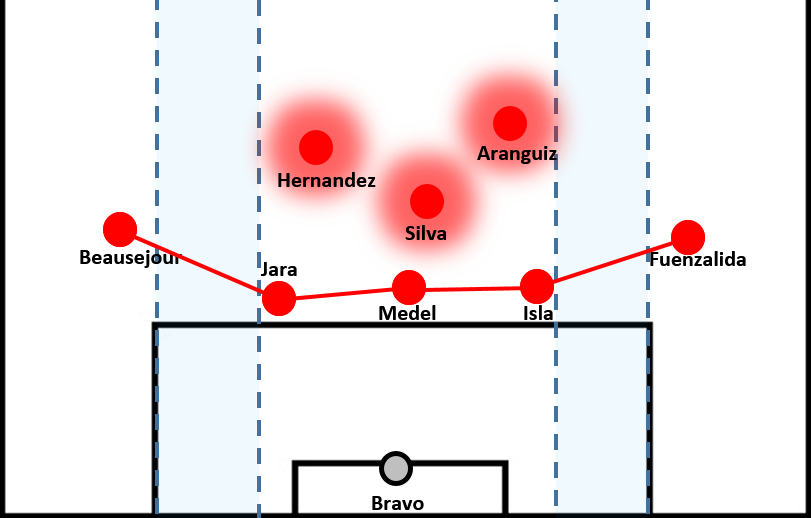
Chile lacking horizontal compactness.
As Fuenzalid was dropping alongside Isla during defending in the defensive third, Chile were changing to a back five.
In such a situation, the wingbacks – Beausejour and Fuenzalida were pressing the player on the wide position but it was creating channels wide enough for Colombian midfielders to send in balls for their forwards to take a shot at the goal. After 20 odd minutes in the first half, Colombia started to gain foothold in the match and started to focus on fast build-ups in order to give Chilean players very less time to perceive the game variables in their surroundings and act accordingly. Colombia started sending vertical passes from the midfield for the forwards to attack. Two or three passes were more than enough for Pekerman’s team to land the ball in the final third.
Also since only Hernandez, Silva and Aranguiz were the only players in front of the defensive line in the central zones, it was left to the Chilean wingbacks to defend the wide spaces. This was costing Chile its horizontal compactness.
Colombia defending, high-press leading to disjointed shapes, free man Zapata.
Since Colombian players were man-marking their opponents when Chile was building from the back, disjointed shapes were created during Colombia’s defensive phase. As Rodriguez and Martinez were high-pressing Chilean centre backs, Silva was dropping to offer numerical superiority at the back. To stop him from being an outlet for Bravo’s pass, even Cardona was getting involved in high –press. Carlos Sanchez was putting a stopper on Aranguiz’s runs and Torres was following Hernandez. This creating openings in the middle. Since Isla was already free on the right wing, him and Fuenzalida were quite capable in putting pressure on Fabra, as explained earlier.
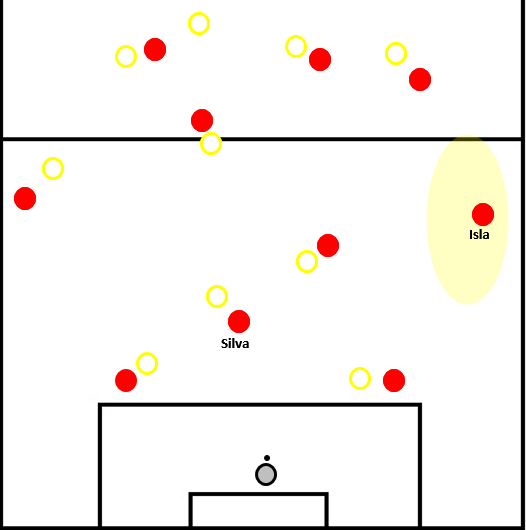
Colombia’s high-pressing and man-orientation during marking.
While Chile had a free man on the wing, with the ability of moving inwards and freeing up space for the central midfielders, Colombia, during high press, focussed on having a free man in the defensive line – most of the time Zapata.

The disjointed shape created as a result of Colombia’s high-pressing. There is no compactness near the ball.
Compactness was one big issue for Colombia, just like it was for Chile in the defensive phase. Isla who was free, was drawing press or forcing Colombian midfielders to press him and thus he was making space for creative players in the middle like Aranguiz. In many situations, Colombia had no access to the ball which was giving free passage to Chile and easy opportunity to beat the press.

Chile exploiting Colombia’s uncompact shape.
Conclusion
Colombia had a tough time in understanding and digesting what Chile was up to. Before Pekerman could make any changes, they were two goals down. Chile also experienced some problems. Although Chile won the game, there were many things that Pizzi could’ve done differently. First of all, the use of Fuenzalida and Isla, two wingbacks on one flank, was a smart but risky move. It didn’t help Chile in establishing central presence as it did against Mexico. With no depth in the middle and penetrative passing options, Chile had to make do with only two players in the central midfield for most part of the game. Secondly, the very same thing hurt them in the defensive phase. Chile struggled to counterpress properly, there was lack of co-ordination among the players and had spacing problems. The absence of Arturo Vidal was felt badly.
Written by Nachiketh Ramesh
- Hipster Guide 2016-17: Fiorentina’s tactics, key players and emerging talents - August 17, 2016
- Euro 2016 Tactical Analysis: Germany 1–1 Italy (6-5 Pens) | Germany and Italy play almost similar systems - July 5, 2016
- Euro 2016 Tactical Analysis: England 1 – 2 Iceland | Tactically disciplined Iceland kicks England out of Europe. - June 29, 2016




















































